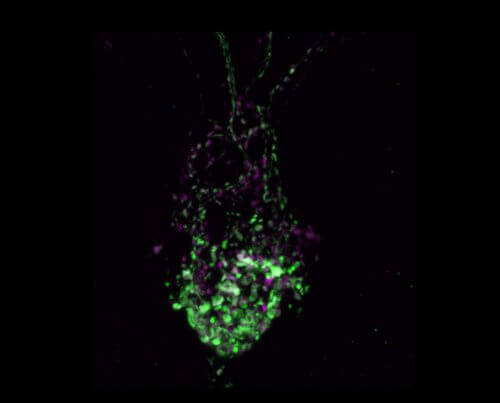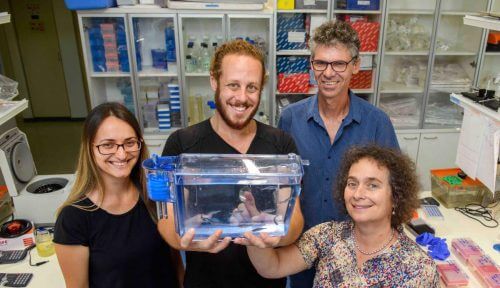How is the stock of the hormone oxytocin replenished in the launching stations in the brain from where it is secreted into the bloodstream?

A burst of happiness sometimes overwhelms new parents looking at their baby or a loving couple exchanging glances. The hormone oxytocin is responsible for the sudden wave of joy. But oxytocin is not only a hormone of love - it plays a role in normal social interaction, in childbirth and breastfeeding, as well as in controlling stress and appetite. Recently, scientists at the Weizmann Institute of Science discovered how the supply of oxytocin is replenished at the launch stations in the brain from where it is secreted into the bloodstream. Their findings may advance the research of various disorders, such as autism, which are suspected to be related to the levels of the hormone and the way it is secreted.
Oxytocin is produced in an area of the brain known as the hypothalamus and from there it is transported to the pituitary gland from where it is secreted to the rest of the body. Prof. Gil Lebkowitz and his group members from the Department of Molecular Biology of the Cell examined the brains of tiny, transparent zebrafish to understand the cellular mechanism that maintains a sufficient supply of oxytocin in the areas of hormone secretion. "In the zebrafish, as in humans, the hormone is packed in vesicles, which are a kind of fatty capsules that move from the cell body to the synapses - the junctions between the nerve cells," says Prof. Lebkowitz.
In order to closely monitor what is happening in the fry's synapses, the researchers, led by postdoctoral researcher Dr. Savani Anblagan and staff scientist Dr. Jeanne Lachman, combined advanced microscopy and genetic engineering methods. Says Prof. Lebkowitz: "The fact that we can see under a microscope what is happening in the brain of the fry, down to the resolution of individual bubbles (about 130 microns only), allows us to monitor - in the living organism - the journey of the hormone from its initial production and packaging site in the body of the nerve cell and up to the point of its secretion in the synapse in the distant part of the cell".

In mammals, when there is a danger of dehydration, oxytocin is released which signals the kidneys to conserve water. Although zebra fish live in fresh water, adding salt to their environment creates an effect similar to dehydration. Therefore, to induce the minnows to secrete oxytocin, the researchers added salt water to the aquarium. The researchers discovered that in a salty environment, oxytocin is quickly released from the bubbles in the synapses, and when the salt is washed out - the oxytocin supply is renewed in them.
A common protein called actin, known mainly as a structural material in the cell, has been marked as the tip of a thread for understanding the process of oxytocin replenishment. When many actin molecules come together, they form long fibers in a process known as polymerization. The researchers saw that these fibers surround the bubbles in the synapses, and in order to better understand their role, they used genetic tools to disrupt their assembly process in the nerve cells that produce and release oxytocin. Later, the researchers developed fluorescent molecular "detectors" that allow the actin fibers and bubbles to be monitored under the microscope, and discovered that it is the dynamic process of breaking down the actin fibers and re-creating them that ensures constant levels of oxytocin in the synapse by regulating the accumulation of bubbles.
In additional experiments, the researchers discovered more molecules that affect the accumulation of these bubbles in the synapse, and therefore also play a role in replenishing the oxytocin supply. Previous studies have shown that the same molecules also play a central role in the actin disassembly and assembly process that occurs during the creation and direction of axons - the extensions of nerve cells used for interneuronal communication in the brain. "It turns out that after the axon has finished developing, the actin polymerization mechanism changes its purpose to keep optimal amounts of the hormone oxytocin available," says Prof. Lebkowitz.
"It is possible to simulate the assembly and disassembly process of actin that regulates the movement of the bubbles to regulate the number of suitcases on the baggage conveyor belt at the airport. If the conveyor belt moves too fast, the porters will not keep up - if it is too slow, the passengers will quickly empty it of luggage. Either way, eventually the conveyor belt will run out. Accordingly, over time, small changes in the efficiency of the bubble transport process may cause larger defects in the body", says Prof. Lebkowitz. "Since there are indications that abnormal activity of oxytocin - or its deficiency - is involved in autism, these findings will therefore provide new research directions about this disorder. Also, the molecules we identified may be involved in regulating other hormones released in the brain."
Michael Glicksberg and Dr. Ludmila Gordon from Lebkowitz's laboratory, Dr. Ron Rothkopf from the Bioinformatics Unit, and Dr. Tali Dadosh and Dr. Eyal Shimoni from the Chemical Research Infrastructure Unit also participated in the study.
In a nerve cell of a rat that produces oxytocin, there are about 15 bubbles carrying the hormone, and in each bubble about 85 of its molecules.
More of the topic in Hayadan:
